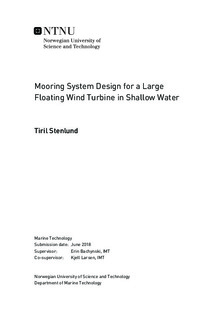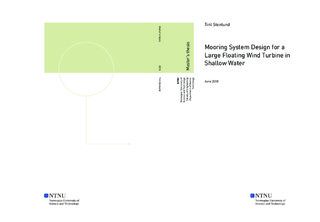| dc.description.abstract | Offshore wind turbines having a semi-submersible sub-structure have been suggested as a good solution at shallow water depths due to its small draft. One of the challenges of having a semi-submersible wind turbine in shallow waters is the mooring system design. The mooring lines should provide enough stiffness to limit the horizontal offset of the structure. However, the stiffness should also be limited to avoid too large forces in the fairleads due to the excitation forces. For chain catenary mooring systems, a large part of the mooring line should be resting on the sea bed to avoid vertical forces at the anchor point. Furthermore, the mooring lines need to have a sufficient Fatigue Limit State (FLS), Ultimate Limit State (ULS) and Accidental Limit State (ALS) when subjected to the environmental forces.
In this Master thesis, an already existing floating semi-submersible wind turbine model in SIMA is implemented from a water depth of 200 m to a water depth of 70 m. The floating wind turbine has a DTU 10MW reference wind turbine, and a semi-submersible sub-structure developed in Qiang Wang's Master thesis. Three different mooring systems have been investigated: The initial mooring system already being in the model, a catenary chain mooring system based on Hywind Scotland mooring system used for the spar buoys in Equinor's pilot park, and a taut polyester system. In addition, the Hywind Scotland model has been compared to a simplified Hywind Scotland model, developed by fellow student Kjetil Blindheim Hole in his Master thesis. The simplified model is modelled without the wind turbine and tower. SIMA has been used to do the model analysis, and MATLAB has been used for validation of static results and for pre-processing.
Static analyses were conducted to find the anchor positions, to find the line characteristics and to find the mooring line shape of the three mooring systems. The natural periods and damping of the models were found in a decay test. The change of mooring system affected the surge and yaw natural period the most, showing that the mooring systems had a minor effect on heave and pitch. Most of the natural periods in surge were too small when comparing to the typical surge periods of a mooring system of a semi-submersible wind turbine. Wave-only response analyses were conducted to find the response amplitude operators (RAOs). The results showed again that the change of mooring system affected heave and pitch motion the least. In addition, resonance peaks were seen for the heave and pitch RAOs.
Constant wind tests were executed for an under rated, and over rated, the rated and a 50 year return period extreme wind condition. The results showed that the rated and the extreme conditions gave the largest mooring line tensions and offsets. Comparing the three mooring line models, the Hywind model gave the largest mean offsets in surge, heave and pitch, while the initial model gave the largest mean line tension.
Extreme conditions were then conducted for all the models. The conditions having extreme turbulent wind was using either NPD turbulent wind or TurbSim turbulent wind. The results showed that the extreme wind affected the mean line tension and the mean offsets in surge and pitch the most. The conditions using the TurbSim model gave a slightly higher wind speed and a lower standard deviation of the wind speed than when using the NPD turbulent model. This could also be seen in the mean line tensions and the mean offsets in surge, heave and pitch. The condition having only extreme waves showed that the extreme waves did not affect the mean line tension, and the mean offsets. However, the extreme waves gave large maximum peaks of the results. Extreme current had a minor effect on the line tension and the offsets.
The ULS mooring line calculations showed that only the polyester system was within the ULS criteria. However, the lee lines of the polyester went into slack. All the systems passed the ALS mooring line criteria, being the extreme ULS condition with one mooring line missing. FLS calculations were not conducted.
When comparing the original Hywind system to the simplified Hywind system, it was found that the results of the simplified model were acceptable. Using the simplified model in an ULS calculation gave a 35 % shorter calculation time in SIMA. | |

